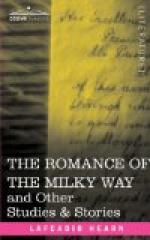Recently, while groping about an old book shop, I found a collection of Goblin Poetry in three volumes, containing many pictures of goblins. The title of the collection is Ky[=o]ka Hyaku-Monogatari, or “The Mad Poetry of the Hyaku-Monogatari.” The Hyaku-Monogatari, or “Hundred Tales,” is a famous book of ghost stories. On the subject of each of the stories, poems were composed at different times by various persons,—poems of the sort called Ky[=o]ka, or Mad Poetry,—and these were collected and edited to form the three volumes of which I became the fortunate possessor. The collecting was done by a certain Takumi Jingor[=o], who wrote under the literary pseudonym “Temm[’e]r R[’e][=o]jin” (Ancient of the Temm[’e]r Era). Takumi died in the first year of Bunky[=u] (1861), at the good age of eighty; and his collection seems to have been published in the sixth year of Ka[’e][:i] (1853). The pictures were made by an artist called Masazumi, who worked under the pseudonym “Ry[=o]sai Kanjin.”
From a prefatory note it appears that Takumi Jingor[=o] published his collection with the hope of reviving interest in a once popular kind of poetry which had fallen into neglect before the middle of the century. The word ky[=o]ka is written with a Chinese character signifying “insane” or “crazy;” and it means a particular and extraordinary variety of comic poetry. The form is that of the classic tanka of thirty-one syllables (arranged 57577);—but the subjects are always the extreme reverse of classical; and the artistic effects depend upon methods of verbal jugglery which cannot be explained without the help of numerous examples. The collection published by Takumi includes a good deal of matter in which a Western reader can discover no merit; but the best of it has a distinctly grotesque quality that reminds one of Hood’s weird cleverness in playing with grim subjects. This quality, and the peculiar Japanese method of mingling the playful with the terrific, can be suggested and explained only by reproducing in Romaji the texts of various ky[=o]ka, with translations and notes.
The selection which I have made should prove interesting, not merely because it will introduce the reader to a class of Japanese poetry about which little or nothing has yet been written in English, but much more because it will afford some glimpses of a supernatural world which still remains for the most part unexplored. Without knowledge of Far Eastern superstitions and folk-tales, no real understanding of Japanese fiction or drama or poetry will ever become possible.
* * * * *




